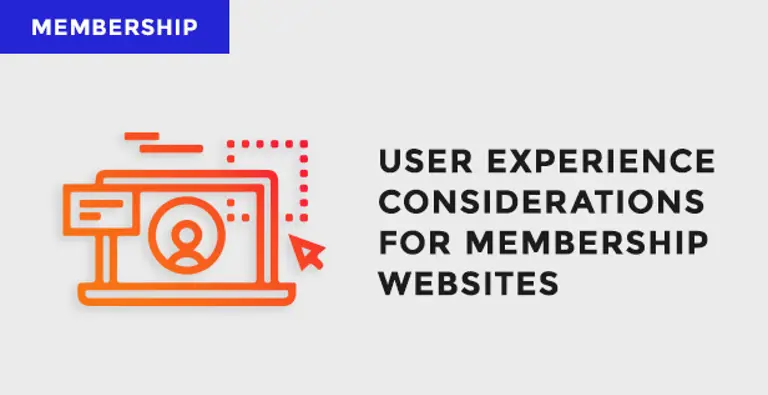Year after year the pace at which society moves is increasing and technology plays a huge part in this. 6 billion people now own a smart device making us more interconnected that ever. We can work on the go, whilst travelling from city to city. Our days have become so packed with tasks and things to do our brains have less time to think. As a result, ease of use is more of a priority now than ever before.
A great example is online banking. Over the last 10 years it’s completely changed the way we manage our money. 10-15 years ago, you’d expect to have to pay your local branch a visit or make a call to the bank to transfer money to someone else's account. Now you can do the same task in 30 seconds using your banks mobile app. Online banking has changed how people think about service and what they expect as customers.
The same applies for membership organisations. The world is changing, and we’ve got to change with it. Here’s the fundamentals to help you think about key aspects of your online offering.

Photo by Kelly Sikkema on Unsplash
Easy Sign-up process
This is key for acquiring new members. You want to reduce any barriers that would make people hesitant to sign up.
New member details
Your sign-up process must be easy to follow and be as short as possible. If you require lots of information from new members, consider only requesting mandatory information at the sign-up stage and take further information at a later stage (preferably by self-serve member portal).
This will reduce the chance of potential members leaving your sign-up page from lack of time or being overwhelmed with too many fields to complete.
Membership levels
If you have different membership levels, make sure they’re listed clearly and the benefits of each level are also easy to understand. If you present this information in a confusing way there’s a chance people will sign-up to the wrong level or leave your website without signing up.
Payments
Many new members will prefer to pay by direct debit however, you should still have the option to pay via card for thesmall amount of people that don’t want to set up a direct debit.
There may be a small percentage of people that prefer to make payment by cheque or BACS. However, we would recommend that you encourage card and direct debit payments only as it’s much easier to manage these forms of payment more efficiently.
Other things to consider
- Organised and simple form formats across different devices
- Easy to understand form validation messages
- Helpful hint tips on form fields to aid understanding of information required
- Consider splitting your sign up process into manageable chunks
- Be clear with costings from the start
- Would the form benefit from a save for later function
What’s next?
Once your new member has entered their contact details, selected their preferred membership level, and made payment they will expect to be told what to do next. This may be different per membership organisation.
It may be that their details need to be verified by the organisation before being accepted as a member, so a simple message informing them of this would be enough.
Or members could be accepted straight away but their email address first needs to be verified so they will be sent a confirmation email requesting them to verify their email address.
These are all important factors to consider when analysing how to improve your registration process.
What do people expect once signed up?
They expect experiences that are interactive, engaging and personalised, with options to self-serve.
So what does this mean?

Photo by Katya Austin on Unsplash
Interactive & Engaging
When browsing your website people like to see things happening, they want to have decisions to make, ‘do I watch this video?’, ‘That looks interesting tell me more’. They like to see colour, images, videos and they want to find your content interesting; so make it interesting for them.
It’s easy to create a static webpage and think everything is covered. ‘All the information our stakeholders could potentially be interested in is included there; job done.’
Not quite.
It’s great that all the content is there but you've got to engage with your audience and direct them to it.
Simplicity is key but that doesn’t mean your website needs to be dull and boring. The same goes for your sign up process. Here are a few things to consider to make your site more engaging:
- A clear, easy to read font will encourage people to actually read your content
- Consider using images or infographics to aid what you’re trying to say
- Videos are another great way to summarise large pieces of text
Self-Service
Now more than ever members with little spare time are expecting self-service options. They don’t have time to send an email and wait for the response or make a call to complete a task. Simple things such as updating addresses can be made much easier by offering a self-serve option.
Membersshould have the ability to log in to a member only portal where they can update their details, manage their membership, book events and complete other member related tasks.
Self-service is a win win for both you and your members as it drastically reduces admin time and adds value to the membership by giving them the freedom to interact with your association whenever and wherever they like.
Scenario
Let’s say you’re a medical organisation that receive abstract submissions from your members which have to go through an approval process before being published
Without a self-serve option this process would be difficult to manage efficiently.
Generally, there’s multiple people involved in the approval process, as the abstracts usually need to be reviewed by different people at certain stages before they’re published. The management of the documents and updates would all be organised and distributed by email which isn’t best practice as there’s lots of room for error.
With self-serve, abstracts can be uploaded via the member portal by the member. If an abstract requires to be reviewed before being accepted, the relevant people will be sent a notification by email that a member has uploaded a submission and a task will be allocated to them to review it. Once reviewed they mark the abstract as complete and the member will then be notified of the outcome and any actions they need to take.
Personalised content
This is something that’s appearing on the radar of more and more membership organisations every year.
When members sign-up they’ll be prompted to select which type of membership they would like and in some cases what area they specialise in and their interests.
Your members are going to select different combinations which means they’ll all want to see different content. With personalisation, your website will show each individual member the content most suited to them and filter out other content it thinks isn’t relevant.
By doing this you’re giving every member that extra bit of value, which isn’t to be underestimated.
So how do we know that this is what members expect?
As a Memberwise recognised supplier we’ve got access to their digital excellence report of 2019. Over 350 association and membership professionals (working at manager level and above) took part in their research.
Here’s what they found were the top 4 expectations for membership websites:
- 88% expect optimised online journeys that save time
- 85% expect and interactive and engaging experience
- 80% expect a high level of self-service
- 78% expect a personlised experience
Summary
There’s a lot to take in here and it can be overwhelming, especially if you’re a fairly new organisation or haven’t had much experience with digital and websites. All of the above is important however we recommend you break it down into bitesize chunks, making all of this easier to chew.
The most important factor is your members, it’s their interests that should ultimately influence your decisions. Start by learning what they value your organisation for. You could do this by surveying them for example. Once you know what they value, you can make a start on the above 4 areas.
All in all, your members want to visit your website and when they leave, they want to have taken something away that’s valuable to them. Whether it’s knowledge or something they can take away and make use of, they’re looking for value.
You’ve got to find a way to give them this as it’s what they expect, starting with the fundamentals outlined in this article.
Get in touch to learn more.





